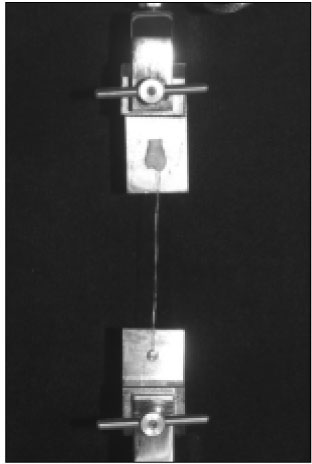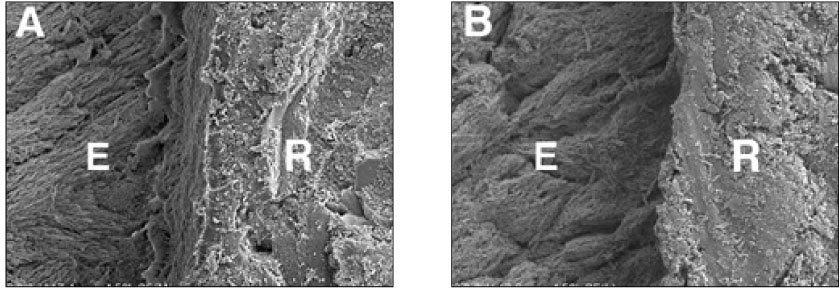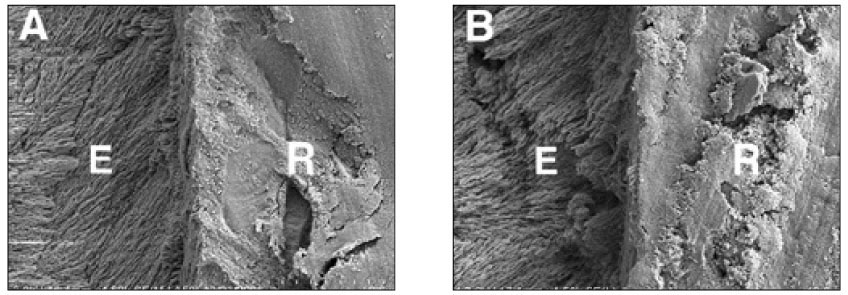J Korean Acad Conserv Dent.
2008 May;33(3):224-234. 10.5395/JKACD.2008.33.3.224.
Effect of the application time of self-etching primers on the bonding of enamel
- Affiliations
-
- 1Department of Conservative Dentistry, College of Dentistry, Chosun University, Korea. ygcho@chosun.ac.kr
- 2Department of Dentistry, College of Medicine, Seonam University, Korea.
- 3Department of Dental Hygine, Seokang College, Korea.
- KMID: 2175985
- DOI: http://doi.org/10.5395/JKACD.2008.33.3.224
Abstract
- The purpose of this study was to compare the normal and two times of application time of six self-etching primers applied to enamel using microshear bond strength (uSBS) test and the finding of scanning electronic microscope (SEM). Crown of sixty human molars were bisected mesiodistally and buccal and lingual enamel of crowns were partially exposed and polished with 600 grit SiC papers. They were divided into one of two equal groups subdivided into one of six equal groups (n = 10) by self-etching primer adhesives. After the same manufacture's adhesive resin and composites were bonded on the enamel surface of each group, the bonded specimens were subjected to uSBS testing and also observed under SEM. In conclusion, generally two times of primer application time increased the enamel uSBS, especially with the statistical increase of bond strength in adhesives involving high-pH primers.
Figure
Reference
-
1. Inoue S, Vargas MA, Abe Y, Yoshida Y, Lambrechts P, Varherle G, Sano H, Van Meerbeek B. Microtensile bond strength of eleven contemporary adhesives to enamel. Am J Dent. 2003. 16:329–334.2. Van Meerbeek B, De Munck J, Matter D, Van Landuyt K, Lambrechts P. Microtensile bond strength of an etch & rinse and self-etch adhesive to enamel and dentin as a function of surface treatment. Oper Dent. 2003. 28:647–660.3. Van Meerbeek B, Peumans M, Gladys S, Braem M, Lambrechts P, Vanherle G. Three-year clinical effetiveness of four total-etch dentinal adhesive systems in cervical lesions. Quintessence Int. 1996. 27:775–784.4. Kanemura N, Sano H, Tagami J. Tensile bond strength to and SEM evaluation of ground and intact enamel surfaces. J Dent. 1999. 27:523–530.
Article5. Toledano M, Osorio R, De Leonardi G, Rosales-Leal JI, Ceballos L, Cabrerizo-Vilchez MA. Influence of self-etching primer on the resin adhesion to enamel and dentin. Am J Dent. 2001. 14:205–210.6. Kiremitci A, Yalcin F, Gokalp S. Bonding to enamel and dentin using self-etching adhesive systems. Quintessence Int. 2004. 35:367–370.7. Vargas M, Cobb D, Denchy G. Interfacial micromorphology and shear bond strength of single-bottle primer/adhesives. Dent Mater. 1997. 13:316–324.
Article8. Hipolito VD, de Goes MF, de Oliveira Carriho MR, Chan DCN, Daronch M, Sinhoreti MAC. SEM evaluation of contemporary self-etching primers applied to ground and unground enamel. J Adhes Dent. 2005. 7:203–211.9. Shimada Y, Senawongse P, Harnirattisai C, Burrow MF, Nakaoki Y, Tagami J. Bond strength of two adhesive systems to primary and permanent enamel. Oper Dent. 2002. 27:403–409.10. Hannig M, Reinhardt KJ, Bott B. Self-etching primer vs phosphoric acid: an alternative concept for composite-to-enamel bonding. Oper Dent. 1999. 24:172–180.11. Van Meerbeek B, De Munck J, Inoue S, Yoshida S, Peumans M, Lambrechts P, Vanherle G. Adhesives and cements to promote preservation dentistry. Oper Dent suppl. 2001. 6:119–144.12. Daronch M, de Goes FM, Grande RHM, Chan DCN. Antibacterial and conventional self-etching primer system: Morphological evaluation of intact primary enamel. J Clin Pediatr Dent. 2003. 27:251–256.13. Nakabayashi N, Pashley DH. Hybridization of dental hard tissue. 1998. Tokyo: Quintessense Publishing Co.;39–44.14. Yoshida Y, Nagakane K, Fukuda R, Nakayama Y, Okazaki M, Shintani H, Inoue S, Tagawa Y, Suzuki K, De Munck J, Van Meerbeek B. Comparative study on adhesive performance of functional monomers. J Dent Res. 2004. 83:454–458.
Article15. Perdigao J, Lopes L, Lambrechts P, Leitao J, Van Meerbeek B. Effects of a self-etching primer on enamel shear bond strengths and SEM morphology. Am J Dent. 1997. 10:141–146.16. Toledano M, Osorio R, De Leonardi G, Rosales-Leal JI, Ceballos L, Cabrerizo-Vilchez MA. Influence of self-etching primer on the resin adhesion to enamel and dentin. Am J Dent. 2001. 14:205–210.17. Ikeda T, Uno S, Tanaka T, Kawakami S, Komatsu H, Sano H. Relation of enamel prism orientation to microtensile bond strength. Am J Dent. 2002. 15:109–113.18. Kerby RE, Knobloch LA, Clelland N, Lilley H, Seghi R. Microtensile bond strengths of one-step and self-etching adheisve systems. Oper Dent. 2005. 30:195–200.19. Moura SK, Pelizza A, Bianco KD, de Goes MF, Loguercio AD, Reis A, Grande RH. Does the acidity of self-etching primers affect bond strength and surface morphology of enamel? J Adhes Dent. 2006. 8:75–83.20. Senawongse P, Sattabanasuk V, Shimada Y, Otsuki M, Tagami J. Bond strength of current adhesive systems on intact and ground enamel. J Esthet Restor Dent. 2004. 16:107–115.
Article21. Torii Y, Itou K, Nishitani Y, Ishikawa K, Suzuki K. Effect of phosphoric acid etching to self-etching primer application on adhesion of resin composite to enamel and dentin. Am J Dent. 2002. 15:305–308.22. Cehreli SB, Eminkahayagil N. Effect of active pretreatment of self-etching primers on the ultramorphology of intact primary and permanent tooth enamel. J Dent Child (Chic). 2006. 73:86–90.23. Miyazaki M, Hinoura K, Honjo G, Onose H. Effect of self-etching primer application method on enamel bond strength. Am J Dent. 2002. 15:412–416.24. Yoshiyama M, Sano H, Ebisu S, Tagami J, Ciucchi B, Carvalho RM, Jonson MH, Pashley DH. Regional strengths of bonding agents to cervical sclerotic root dentin. J Dent Res. 1996. 75:1404–1413.
Article25. Lopes GC, Marson FC, Vieira LCC, de Andrada MAC, Baratieri LN. Composite bond strength to enamel with self-etching primers. Oper Dent. 2004. 29:424–429.26. Finger WJ, Tani C. Effect of application modes on bonding performance of self-etching adhesives. Am J Dent. 2005. 18:41–44.27. Yamada T, Sugizaki J. Basic properties and clinical application of the Clearfil SE Bond. 2000. In : Processing of the international Kuraray Symposium; Osaka. 1–6.28. Van Meerbeek B, Vargas M, Inoue S, Yoshida Y, Perdigao J, Lambrechts P, Vanherle G. Microscopy investigations. Techniques, results, limitations. Am J Dent. 2000. 13:3D–18D.29. Hotta K, Mogi M, Miura F, Nakabayashi N. Effects of 4-MET on bond strength and penetration monomers into enamel. Dent Mater. 1992. 8:173–175.30. Yoshida Y, Van Meerbeek B, Nakayama Y, Snauwaert J, Hellemans L, Lambrechts P, Vanherle G, Wakasa K. Evidence of chemical bonding at biomaterial-hard tissue interfaces. J Dent Res. 2000. 79:709–714.
Article31. Ferrari M, Mannocci F, Vichi A, Davidson CL. Effect of two etching timers on the sealing ability Clearfil Liner Bond 2 Class V restorations. Am J Dent. 1997. 10:66–70.32. Tay FR, Pashley DH. Aggressiveness of contemporary self-etch adhesives. I: Depth of penetration beyond dentin smear layers. Dent Mater. 2001. 17:296–308.33. Tay FR, Pashley DH, King NM, Carvalho RM, Tsai J, Lai SCN, Marquezini L. Aggressiveness of self-etch adhesives on unground enamel. Oper Dent. 2004. 29:309–316.
- Full Text Links
- Actions
-
Cited
- CITED
-
- Close
- Share
- Similar articles
-
- Comparison of shear bond strength of different bonding systems on bleached enamel
- Influence of additional etching on shear bond strength of self-etching adhesive system to enamel
- Evaluation of Microtensile Bond Strength of Sealant Depending on the Duration of Etching and the Use of Bonding Agent
- Orthodontic bonding to acid- or laser-etched prebleached enamel
- The effects of a sealant resin on enamel demineralization in orthodontic bracket bonding




